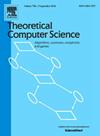Bike-assisted evacuation of robots on a line with asymmetric S/R communication
IF 1
4区 计算机科学
Q3 COMPUTER SCIENCE, THEORY & METHODS
引用次数: 0
Abstract
Two autonomous mobile robots and a non-autonomous one, also called bike, are placed at the origin of an infinite line. The autonomous robots can travel with maximum speed 1. When a robot rides the bike its speed increases to . Exactly one robot at a time can ride the bike, moreover the bike is non-autonomous in that it cannot move on its own. An Exit is placed on the line at a location which is unknown to the robots and at distance d from the origin. The robots have limited communication behavior; one robot is a sender (denoted by S) in that it can send information wirelessly at any distance and receive messages only in F2F (Face-to-Face), while the other robot is a receiver (denoted by R) in that it can receive information wirelessly but can send information only F2F. The bike has no communication capabilities of its own. We refer to the resulting communication model of the ensemble of the two autonomous robots and the bike as S/R.
Our general goal is to understand the impact of the non-autonomous robot in assisting the evacuation of two communication-limited autonomous robots. Our main contribution is to provide a new evacuation algorithm that enables both robots to evacuate from the unknown Exit in the S/R model. We also analyze the resulting evacuation time as a function of the bike's speed v and give upper and lower bounds on the competitive ratio of the resulting algorithm for the entire range of possible values of v.
非对称S/R通信线路上机器人的自行车辅助疏散
两个自主移动机器人和一个非自主移动机器人,也称为自行车,被放置在无限直线的原点。自主机器人可以以最高速度行驶。当机器人骑自行车时,它的速度增加到1倍。每次只能有一个机器人骑自行车,而且自行车是非自主的,因为它不能自己移动。出口被放置在线路上一个机器人不知道的位置,距离原点d。机器人的交流行为有限;一个机器人是发送者(S),它可以在任何距离无线发送信息,只以F2F(面对面)方式接收信息;另一个机器人是接收者(R),它可以无线接收信息,但只以F2F方式发送信息。这种自行车本身没有通讯功能。我们将最终得到的两个自主机器人和自行车的集成通信模型称为S/R。我们的总体目标是了解非自主机器人在协助两个通信受限的自主机器人疏散时的影响。我们的主要贡献是提供了一种新的疏散算法,使两个机器人都能从S/R模型中的未知出口疏散。我们还分析了最终的疏散时间作为自行车速度v的函数,并给出了结果算法在整个v可能值范围内的竞争比的上界和下界。
本文章由计算机程序翻译,如有差异,请以英文原文为准。
求助全文
约1分钟内获得全文
求助全文
来源期刊

Theoretical Computer Science
工程技术-计算机:理论方法
CiteScore
2.60
自引率
18.20%
发文量
471
审稿时长
12.6 months
期刊介绍:
Theoretical Computer Science is mathematical and abstract in spirit, but it derives its motivation from practical and everyday computation. Its aim is to understand the nature of computation and, as a consequence of this understanding, provide more efficient methodologies. All papers introducing or studying mathematical, logic and formal concepts and methods are welcome, provided that their motivation is clearly drawn from the field of computing.
 求助内容:
求助内容: 应助结果提醒方式:
应助结果提醒方式:


